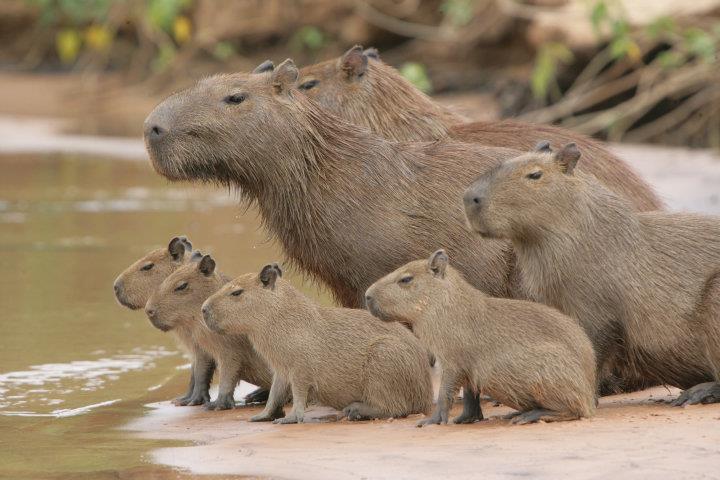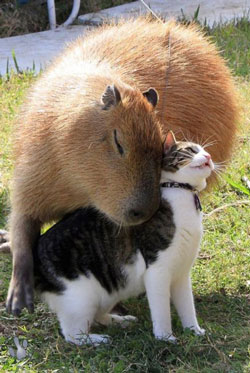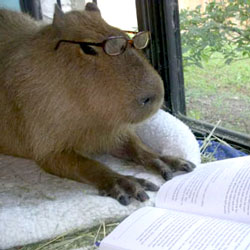Inspect Element Activity
There are 5 differences between Side A and Side B. Can you spot them?
Use the inspector tool in your browser to make Side B match Side A.
Side A
The Capybara
Hydrochoerus hydrochaeris

Capybaras are large rodent relatives of the guinea pig. Weighing between 77 and 125 lbs when they reach adulthood, they are the largest rodents in the world. Native to South America, the capybara inhabits savannas and dense forests and lives near bodies of water. It is a highly social species and can be found in groups as large as 100 individuals, but usually lives in groups of 10–20 individuals. The capybara is not a threatened species.
 Though quite agile on land (capable of running as fast as a horse), capybaras are equally at home in the water. They are excellent swimmers, and can remain completely submerged for up to five minutes, an ability they use to evade predators. Capybaras can sleep in water, keeping only their noses out of the water. As temperatures increase during the day, they wallow in water and then graze during the late afternoon and early evening. They also spend time wallowing in mud. They rest around midnight and then continue to graze before dawn.
Though quite agile on land (capable of running as fast as a horse), capybaras are equally at home in the water. They are excellent swimmers, and can remain completely submerged for up to five minutes, an ability they use to evade predators. Capybaras can sleep in water, keeping only their noses out of the water. As temperatures increase during the day, they wallow in water and then graze during the late afternoon and early evening. They also spend time wallowing in mud. They rest around midnight and then continue to graze before dawn.
Capybaras are gregarious. While they sometimes live solitarily, they are more commonly found in groups of around 10–20 individuals, with two to four adult males, four to seven adult females, and the remainder juveniles. Capybara groups can consist of as many as 50 or 100 individuals during the dry season when the animals gather around available water sources. Males establish social bonds, dominance, or general group consensus. They can make dog-like barks when threatened or when females are herding young.
| Capybara Scientific Classification | |
|---|---|
| Kingdom | Animalia |
| Phylum | Chordata |
| Class | Mammalia |
| Order | Rodentia |
| Family | Caviidae |
| Genus | Hydrochoerus |
| Species | H. hydrochaeris |
Side B
The Capybara
Hydrochoerus hydrochaeris

Capybaras are large rodent relatives of the guinea pig. Weighing between 77 and 125 lbs when they reach adulthood, they are the largest rodents in the world. Native to South America, the capybara inhabits savannas and dense forests and lives near bodies of water. It is a highly social species and can be found in groups as large as 100 individuals, but usually lives in groups of 10–20 individuals. The capybara is not a threatened species.
 Though quite agile on land (capable of running as fast as a horse), capybaras are equally at home in the water. They are excellent swimmers, and can remain completely submerged for up to five minutes, an ability they use to evade predators. Capybaras can sleep in water, keeping only their noses out of the water. As temperatures increase during the day, they wallow in water and then graze during the late afternoon and early evening. They also spend time wallowing in mud. They rest around midnight and then continue to graze before dawn.
Though quite agile on land (capable of running as fast as a horse), capybaras are equally at home in the water. They are excellent swimmers, and can remain completely submerged for up to five minutes, an ability they use to evade predators. Capybaras can sleep in water, keeping only their noses out of the water. As temperatures increase during the day, they wallow in water and then graze during the late afternoon and early evening. They also spend time wallowing in mud. They rest around midnight and then continue to graze before dawn.
Capybaras are gregarious. While they sometimes live solitarily, they are more commonly found in groups of around 10–20 individuals, with two to four adult males, four to seven adult females, and the remainder juveniles. Capybara groups can consist of as many as 50 or 100 individuals during the dry season when the animals gather around available water sources. Males establish social bonds, dominance, or general group consensus. They can make dog-like barks when threatened or when females are herding young.
| Capybara Scientific Classification | |
|---|---|
| Kingdom | Animalia |
| Phylum | Chordata |
| Class | Mammalia |
| Order | Rodentia |
| Family | Caviidae |
| Genus | Hydrochoerus |
| Species | H. hydrochaeris |
